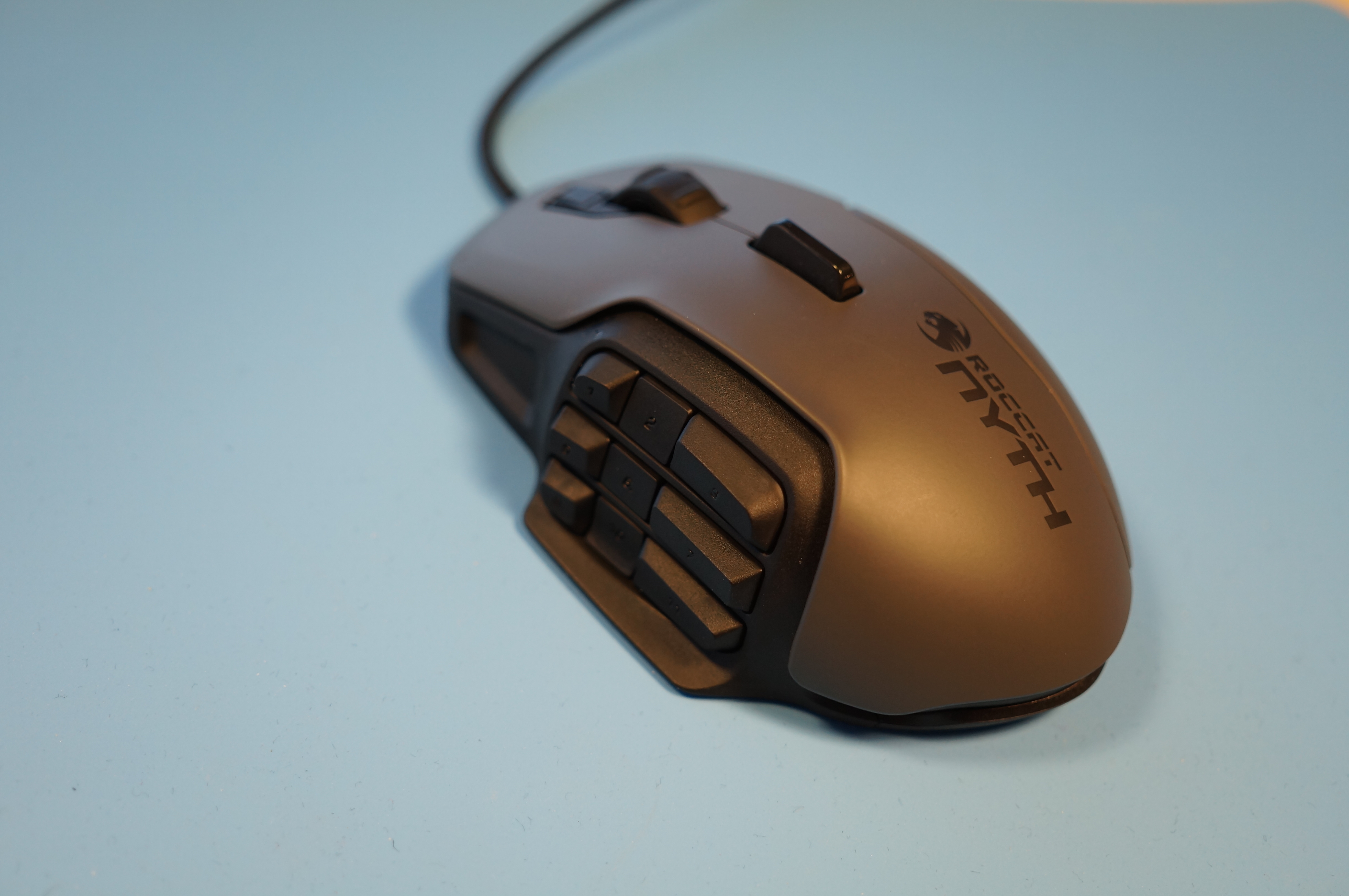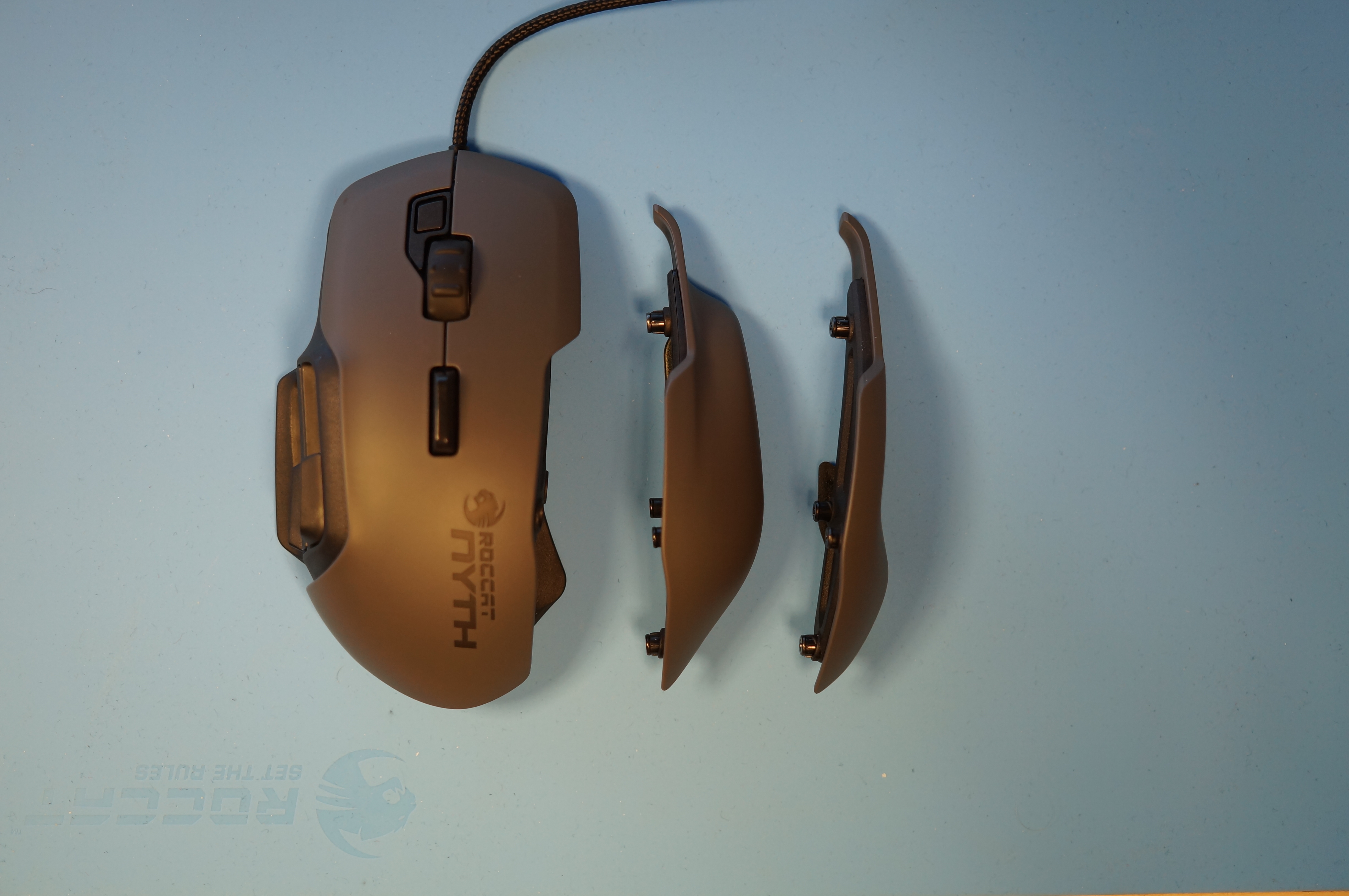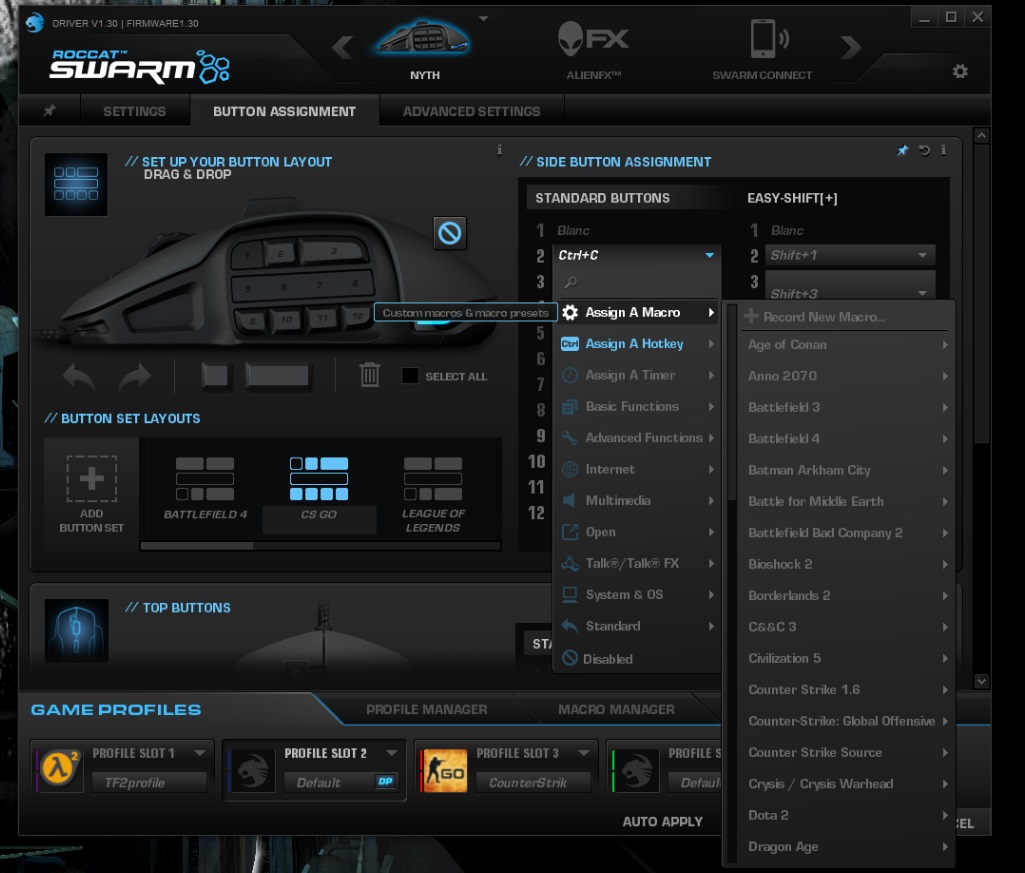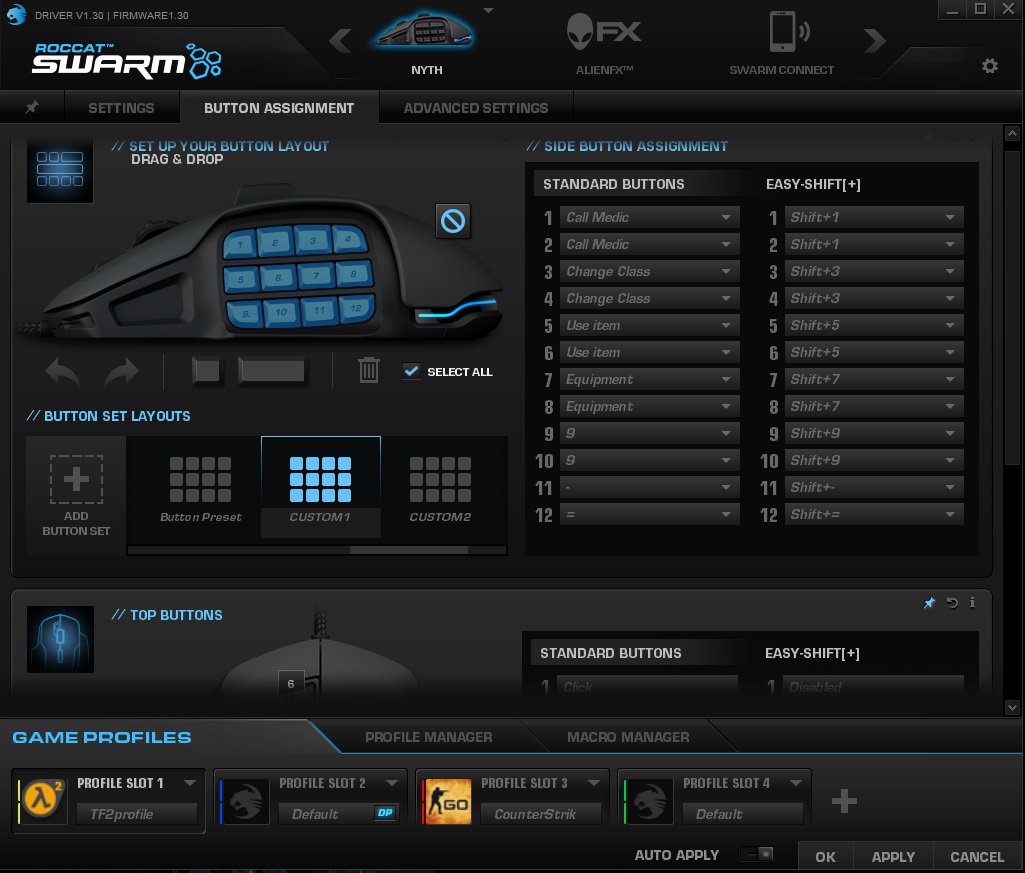The Roccat Nyth is the best customizable mouse I've ever used

The Roccat Nyth is the most exciting gaming mouse I’ve used in a long time. I don’t think it’s the best gaming mouse I’ve ever used, but it’s absolutely the most customizable, with a case of pop-in thumb buttons and two different pinky grip options. The Roccat Nyth gets its modular design so right, it’s hard to imagine why no one had done it before. The truth is, of course, it’s been tried, most notably with the Razer Ouroboros and Mad Catz R.A.T., but the Nyth offers a better contoured body than either out of the box, with more choices for thumb buttons that make it a decent mouse for anything from shooters to MMOs.
Surprisingly, it’s Roccat’s new Swarm driver software that really makes the mouse shine, with some of the most powerful and easy to use macro and button mapping tools available for any gaming mouse. And with a mouse this customizable, that’s not just a bonus. It’s vital.
Before we get to the customizable thumb buttons, let’s go over the basics of the Nyth. The mouse has a tactile plastic scroll wheel with a button in front of it and slightly offset to the left, which is easy to press with your index finger. It also has a rocker placed center of mass, which sits between index and middle finger, and can be clicked left or right. Roccat calls it the dorsal fin switch. The rocker serves the same purpose as a scroll wheel that can click left or right, like the Roccat Kone XTD’s.
Unfortunately, I think the rocker’s placement makes this awkward. I love sideways clicking a scroll wheel to quickly navigate forward/back on web pages, but the rocker is too far back to comfortably press with either finger. It’s the one feature of the Nyth’s design that I dislike.

The right side of the mouse can be outfitted with two different plastic grips: a narrow, curved grip that you’ll want to use with a claw grip or a more active palm grip, and a wider grip with a pinky rest that MMO palmers will likely prefer. Swapping them out takes about three seconds: they’re held in place by strong magnets and snap onto the mouse body with surprising force. It’s such a simple mechanism that it feels like the grips would pop off during regular use, but from my couple weeks with the Nyth, they’re rock solid. You could easily use the mouse without even realizing the grip is removable.
I prefer the smaller grip, which gives the Nyth a slimmer profile that feels like the right size and weight for general gaming. I used the mouse to play a variety of games, from Team Fortress 2 and Killing Floor 2 to Nuclear Throne, and found it comfortable and easy to control.
The star of the Nyth, of course, is its grid of thumb buttons. There are slots for 12 small buttons in three rows of four, just like the Razer Naga or the Logitech G600. Some gamers swear by that array of a dozen buttons, for MMOs and even first-person shooters. While I get the appeal for MMOs, where you’re juggling dozens of abilities, I find those multi-button arrays terrible for shooters and other high-speed games. They take up too much space, limiting the surface area you can grip without accidentally pressing a button. And the buttons themselves are small and virtually identical, meaning you’re much more likely to press the wrong button in the heat of the moment. They’re not ideal for precise control or quick button presses.
Keep up to date with the most important stories and the best deals, as picked by the PC Gamer team.

So I didn’t expect to like the Nyth, but its optional button configurations are great. Its dual-length buttons can turn a samey array of 12 buttons into a far more manageable array of six. Even better are the ‘blank’ pieces that can turn an entire row, or an individual button space, into a flat, grippable surface. The possibilities are fantastic, letting you mix-and-match different size buttons in different size layouts, like three small buttons aligned vertically at the front end of the grid, three double-wide buttons aligned vertically at at the back, and a blank column in between. Or six small buttons laid out in two columns, with blank spaces in between. Or one row of buttons with blank spaces beneath.
The customization options are great, but more importantly, the thumb buttons feel even better than many gaming mice I’ve used. They don’t quite have the satisfying clicky, tactile feedback of the best mice buttons, like the Razer Deathadder’s, but they still give off a noticeable click, and aren’t as mushy as I feared when I first went hands-on with the mouse. They’re a little soft to the touch, without negatively affecting performance in the least. The double-wide buttons, especially, are nicely contoured and fit well under the thumb.
Swarm's macro features actually made me interested in programming or assigning macros for my games.
What really makes all of this work is Roccat’s new Swarm software, which replaces the old driver software used for its previous mice and keyboards. Roccat’s old drivers were packed with features, but so dense that it could be hard to find what you needed. They also had some annoyances enabled by default, like an achievement system tied to obnoxious VO that yelled at you when you ‘leveled up.’ Swarm mercifully disables that stuff by default, and lays out important controls like button mapping, DPI and sensitivity on easy to use tabs. The UI has more breathing room and is easier to navigate.
Assigning commands to the thumb buttons is surprisingly easy thanks to two great interfaces. First, there’s the drag-and-drop interface for the button grid, which lets you create and then choose templates based on how you have the keys configured. The second is the truly massive list of pre-configured game macros that can be assigned to those buttons, as well as more generic commands, like media playback controls, web browser navigation, and so on. The game macros are the especially interesting part: Roccat has hundreds of macros stored for various games, and you can easily modify and create your own in Swarm, too.

I don’t love Swarm’s macro features because I’m a big macro user. I almost never use macros. I love it because it’s so well-implemented, it actually made me interested in programming or assigning macros for my games. It made me reconsider the way I use a gaming mouse, and the best way to assign controls for various games. I’m used to assigning buttons in-game, but Swarm made it more appealing to assign commands in the driver software, because it’s easy to use and there are tons of presets as examples.
I also saw how Swarm could make that experience better. Assigning button commands in-game works just fine, but when you start switching out the buttons on the Nyth, and assigning different buttons to different profiles, that’ll make for a lot of re-assigning controls in-game. Saved profiles in Swarm, on the other hand, can be tied to whatever button layout you choose, and then set to activate based on specific executables you boot up. With a bit of setup time, you can have all your mouse controls automatically kick in when you boot up a game.
The Nyth hardware is cool by itself, and the software is useful by itself. In unison, they’re fantastic—although the software could be even better. There are tooltips designed to help new users understand what different settings do and mean, but they don’t provide any extra information (the tooltip for Sensitivity settings, for example, says ‘set your mouse sensitivity’). With a little more work, Swarm may be the best mouse software in gaming.

The Nyth felt good in my hand, though at 136 grams it’s a touch on the heavy side. Its Philips Twin Eye Sensor supports up to 12,000 DPI, which is certainly overkill, and I don’t know if tracking remains consistent at high settings (you can read more about DPI and tracking performance in my Gaming mouse myths busted article). The mouse did exhibit some high lift-off distance issues that surface tuning didn’t seem to fix, but setting the lift-off distance to ‘very low’ solved the problem.
From my time gaming with the mouse, mostly at 1600 DPI, I didn’t detect any issues with acceleration or inaccurate tracking. The Nyth is by far the best customizable mouse I’ve used, but I don’t know if it’s the right buy for many gamers. At $120, it’s far more expensive than most of my recommended gaming mice, and customizing your mouse for different games is absolutely a niche interest. But if that’s an interest you have, this is the mouse to get.

Wes has been covering games and hardware for more than 10 years, first at tech sites like The Wirecutter and Tested before joining the PC Gamer team in 2014. Wes plays a little bit of everything, but he'll always jump at the chance to cover emulation and Japanese games.
When he's not obsessively optimizing and re-optimizing a tangle of conveyor belts in Satisfactory (it's really becoming a problem), he's probably playing a 20-year-old Final Fantasy or some opaque ASCII roguelike. With a focus on writing and editing features, he seeks out personal stories and in-depth histories from the corners of PC gaming and its niche communities. 50% pizza by volume (deep dish, to be specific).

